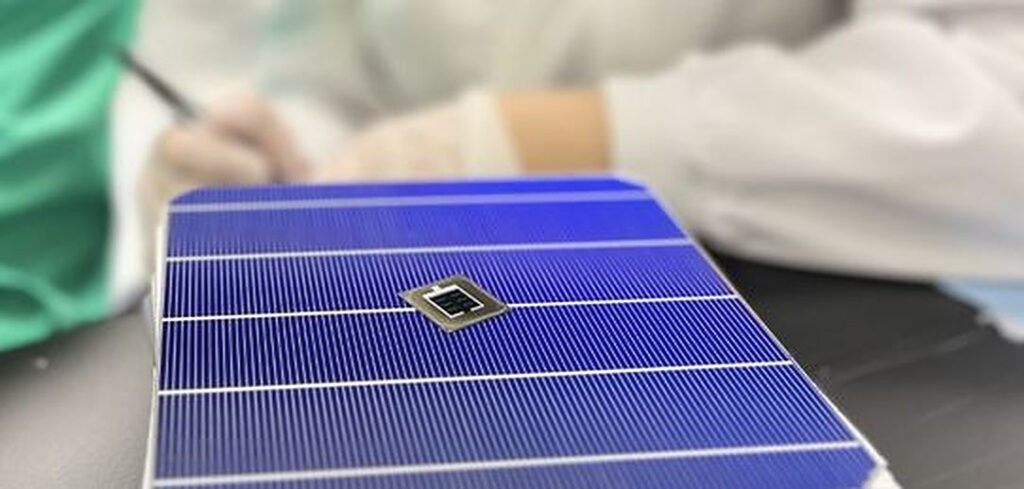The Saudi research institute said its new four-junction tandem device has achieved the highest efficiency ever reported for perovskite-based 4-T and triple-junction tandem solar cells to date. The main feature of the cell is the hole transport layer of the top perovskite cell, which is designed with self-assembled monolayers.
Researchers from King Abdullah University of Science and Technology (KAUST) in Saudi Arabia have fabricated a semi-transparent four-terminal (4T) perovskite-perovskite-silicon tandem solar cell with an active surface area of 1 cm2.
“After double-junction perovskite/silicon solar cells, there will be three-junction perovskite/perovskite/silicon tandems,” says the lead author of the study, Stefaan De Wolf. pv magazine. “However, processing compatibility can be a major challenge when depositing so many layers, with the recombination connection between the perovskite top and the perovskite mid-cell being particularly challenging. Furthermore, this approach places the top cell on glass, opening the design space for highly efficient and robust top cells.”
The scientists said the key feature of the new tandem device was the hole transport layer (HTL) of the top cell, which was designed with self-assembled monolayers (SAMs) based on a compound known as poly(9,9-bis( 3′-(N,N-dimethyl)-N-ethylammoinium-propyl-2,7-fluorene)-alt-2,7-(9,9-dioctylfluorene))dibromide (PFN-Br), which in turn was combined with sputtered nickel oxide (NiOx).
The top perovskite solar cell is built with a substrate made of glass and indium tin oxide (ITO), the HTL based on carbazole (2PACz), PFN-Br and NiOx, an absorber that relies on a perovskite material known as Cs0.1FA0. 9PbI1Br1.96Cl0.04, an electron transport layer based on buckminsterfullerene (C60) and tin(IV) oxide (SnO2) layer, an ITO electrode, a silver (Ag) metal contact, and an anti-reflective coating based on magnesium fluoride (MgF2).
This device achieved an energy conversion efficiency of 14.3%, an open-circuit voltage of 1.402 V, and a short-circuit current density of 12.5 mA/cm2and a fill factor of 81.5%
The middle perovskite device and the bottom silicon cell were integrated into a monolithic perovskite/silicon tandem cell that achieved an efficiency of 17.2%, an open-circuit voltage of 1.783 V, and a short-circuit current density of 11.6 mA/cm.2and a fill factor of 83.0%.
The tandem device was able to achieve an efficiency of 31.5%, which the scientists say is the highest efficiency ever reported for perovskite-based 4-T and triple-junction tandem solar cells to date. Furthermore, they found that all devices were able to maintain 80% of their initial efficiency after 1500 minutes of maximum power point tracking, which they described as a “significant” result for the 2.0 eV bandwidth organic-inorganic perovskite material they chose for the top cell.
“The HTL showed a wide spread across all PV parameters, with one-third of all devices fully bridged,” the researchers said. “This fully bridged performance comes from the not fully covered perovskite films in the device, attributed to the hydrophobic surface of 2PACz-anchored ITO substrates.”
The new cell was described in the paper “Four-terminal perovskite/perovskite/silicon triple-junction tandem solar cells with more than 30% energy conversion efficiency,” published in ACS Energy Lett. “The results underline the potential of the triple-junction tandem solar cells and highlight the importance of good perovskite-perovskite bonding layers in monolithic 3-J solar cells to unlock their full potential,” the academics concluded.
Popular content
In January, KAUST announced that it had fabricated a perovskite-perovskite-silicon triple-junction solar cell with an energy conversion efficiency of 26.4%. It will be in May 2023 achieved an efficiency of 33.7% for a perovskite-silicon tandem solar cell.
A few months earlier, the Saudi university announced a efficiency of 28.1% for a perovskite-silicon tandem solar cell based on textured silicon wafers. In August 2022, it claimed a 26.2% efficiency for a monolithic perovskite-silicon tandem photovoltaic device.
In December 2021, KAUST researchers achieved this an energy conversion efficiency of 28.2% for a tandem solar cell with an area of approximately 1 cm2, based on a nip perovskite stacked on top of a silicon heterojunction.
The same research group recently announced an inverted perovskite-silicon tandem solar cell with a 1 nm magnesium fluoride (MgFx) interlayer placed between the perovskite layer and the hole transport layer (HTL) to reduce voltage losses.
This content is copyrighted and may not be reused. If you would like to collaborate with us and reuse some of our content, please contact: editors@pv-magazine.com.

